The Spatial Spillover Effects of Environmental Regulations on Forestry Ecological Security Efficiency in China
Abstract
:1. Introduction
2. Literature Review
3. Materials and Methods
3.1. Research Methodology
3.1.1. Super-Efficient SBM Model
3.1.2. Spatial Correlation Test
3.1.3. Spatial Econometric Model
3.2. Data Sources
3.2.1. Calculation of ER Indicators
3.2.2. Calculation of FESE Indicators
3.2.3. Calculation of Indicators for Other Impact Factors
- The FESE decomposition efficiency: Technical efficiency (TFESE) and scale efficiency (SFESE) are studied in terms of both production technology and scale to promote FESE [31]. Technical efficiency indicates the productivity influenced by factors such as management and technology, and scale efficiency is the productivity influenced by the scale factor. The expansion of the forest ecological security production scale implies an expansion of forest land area. The land and area are limited, and the forest land area has a crowding-out effect on other land areas; therefore, a large-scale expansion of the forest land area is unrealistic. Under the condition that the forest land area is not encroached upon, the contribution of technical efficiency to FESE is enhanced so that FESE can be effectively increased.
- Trade dependence (TD): Trade dependence characterizes the degree of foreign openness, and expanding the degree of foreign openness is conducive to the introduction of advanced experience and practical technology [32]. In China’s foreign trade, in 2010, log exports were USD 11 million, and imports were USD 6,071 million. By 2019, log exports were USD 15 million, and imports were USD 9,434 million. In 2010, furniture exports were USD 16.157 billion and imports were USD 388 million. By 2019, furniture exports were predicted to be USD 19.920 billion and imports USD 1.064 billion (these data are from the China Forestry and Grassland Statistical Yearbook, which is up to date to 2019 of CNKI, with a comparison of data before and after 10 years selected). The data from China’s forest products import and export trade show that China’s forest products, raw materials imports, and furniture exports are increasingly dependent on foreign trade, which reflects the fact that forestry policies effectively protect China’s forest resources and promote FESE. This is measured by the ratio of total exports and imports to GDP.
- State investment (SI): Refers to the proportion of the state’s completed investment in forestry ecological construction. State investment contributes significantly and positively to the development of forestry [31]. Between 1981 and 1995, there was a major shift in the direction of investment in forests in China, with ecological investments becoming the focus of government financial investment. The act of restoring and protecting forest resources has public attributes, so it is not feasible to rely on market regulation. China’s fiscal spending on forestry ecological projects has a guiding effect on local governments, which is conducive to the enhancement of FESE. This is measured by state investment in forestry as a percentage of total forest investment.
- Science and technology innovation (ST): Indicates the creation and application of new knowledge, techniques and technologies in forestry ecology to improve forest quality and provide new services. Science and technology innovation can improve and promote social production and provide support for the development of high-quality forests [33]. The application of science and technology innovation in breeding, pest control, and management in forestry production effectively improves the performance of forestry germplasm resources, reduces risks in forestry growth, and establishes forestry information systems. The six major projects being implemented in forestry cannot be achieved without the support of science and technology innovation driving the growth of the FESE. This is measured by the number of patents filed, unit: piece.
- Forestry productive services (PS): Refers to service industries that provide safeguarding services to maintain the continuity of forestry ecology and promote technological progress, industrial upgrading and increasing efficiency. Forestry productive services provides important support to promote the development of forests on a large scale and to improve the comprehensive production capacity of forests, while alleviating the binding of forest production by capital, technology, materials, and labor [23]. Provincial government forestry policies are based on policy guidance and financial allocations from the central government, and there is a gap between them, and the production factors required for actual forestry production. Government forestry policies are more fixed for forestry production, while productive forestry services fill this gap by providing farmers with the resources needed for forestry production in a flexible manner. This is measured by the ratio of the number of regional service workers to the area of the region.
- Labor force literacy level (LF): It is the literacy level of the workforce that carries out forestry ecology construction. The higher the literacy level of producers in forest labor, the more conducive it is to the rational allocation of production factors and the mastery of production technology [34]. The higher the literacy level of the members of the forestry grassroots cadres, the more conducive it is to innovation and the promotion of forestry technology, improving the management level of forestry production and promoting the improvement of FESE. This is measured by years of education per capita, unit: year.
- Percentage of forest land affected (FL): Indicates the area of forest land that has suffered some degree of damage to forest resources and their environment under the influence of natural factors, human or both. The larger the percentage of affected area of forest land, the greater the threat to forest production [34]. The affected area responds to the natural environmental conditions of the forest production, and a larger affected area indicates a less stable forest ecosystem. The construction of forestry ecological security relies mainly on natural forces, and the lower level of natural forces inhibits the improvement of FESE. This is measured as the ratio of affected forest land area to the total forest land area.
- The definition of variables and descriptive statistics in this paper are given in Table 3, where the VIF value of each variable is much lower than 10, so there is no multicollinearity. It is worth noting that the core explanatory variable ER takes values in the range [−1.550, 1.500], when ER is 0 (an ER less than 0 indicates that the ER is below average; an ER greater than 0 indicates that the ER is above average.)means that ER is at the average level of the study range, and in 2011, ER reached the average level in most Chinese provinces.
4. Results
4.1. Spatial Pattern Evolution of FESE and ER
4.2. Spatial Correlation Test of FESE
4.2.1. Global Spatial Correlations
4.2.2. Local Spatial Correlations
4.3. Selection and Regression of the Spatial Econometric Model
5. Robustness Test
6. Discussion
6.1. Measurement of FESE
6.2. FESE Enhancement Relies Mainly on Scale Efficiency
6.3. Association between ER and FESE
7. Conclusions and Policy Implication
7.1. Conclusions
7.2. Policy Implication
Author Contributions
Funding
Institutional Review Board Statement
Informed Consent Statement
Data Availability Statement
Acknowledgments
Conflicts of Interest
Appendix A
| 2005 | 2006 | 2007 | 2008 | 2009 | 2010 | 2011 | 2012 | |
| Beijing | 0.05067 | 0.03570 | 0.03229 | 0.03272 | 0.03867 | 0.04008 | 0.04346 | 0.04205 |
| Hebei | 0.07988 | 0.07813 | 0.07442 | 0.07189 | 0.07878 | 0.07792 | 0.08196 | 0.08164 |
| Shanxi | 0.07110 | 0.06941 | 0.06791 | 0.06560 | 0.06822 | 0.06765 | 0.06813 | 0.06758 |
| Inner Mongolia | 0.40151 | 0.44005 | 0.36247 | 0.37294 | 0.35794 | 0.36554 | 0.38624 | 0.38433 |
| Liaoning | 0.25420 | 0.25299 | 0.24831 | 0.23652 | 0.23035 | 0.22670 | 0.23753 | 0.24585 |
| Jilin | 1.17599 | 1.17290 | 1.17041 | 1.17041 | 1.14417 | 1.14837 | 1.14851 | 1.15063 |
| Heilongjiang | 1.05191 | 1.10872 | 1.08751 | 1.09976 | 1.12497 | 1.12821 | 1.15880 | 1.18036 |
| Jiangsu | 0.10153 | 0.09497 | 0.09664 | 0.08403 | 0.11168 | 0.11635 | 0.11660 | 0.10914 |
| Zhejiang | 0.19348 | 0.20158 | 0.21788 | 0.22631 | 0.32194 | 0.33285 | 0.34324 | 0.35349 |
| Anhui | 0.19440 | 0.19524 | 0.19597 | 0.19456 | 0.22808 | 0.22881 | 0.22036 | 0.21400 |
| Fujian | 0.57745 | 0.61980 | 1.03354 | 1.07338 | 1.12678 | 1.17751 | 1.14649 | 1.12904 |
| Jiangxi | 1.03915 | 0.45636 | 0.42663 | 0.38345 | 0.38841 | 0.35976 | 0.37270 | 0.37994 |
| Shandong | 0.06290 | 0.06151 | 0.06101 | 0.06110 | 0.09937 | 0.10015 | 0.09828 | 0.09638 |
| Henan | 0.13307 | 0.12991 | 0.13128 | 0.12948 | 0.15807 | 0.15680 | 0.16129 | 0.16302 |
| Hubei | 0.16415 | 0.16463 | 0.16800 | 0.16626 | 0.20167 | 0.19989 | 0.20919 | 0.20588 |
| Hunan | 0.24498 | 0.23351 | 0.22769 | 0.22418 | 0.25795 | 0.24504 | 0.24490 | 0.22941 |
| Guangdong | 0.37853 | 0.39637 | 0.42068 | 0.47478 | 0.43533 | 0.42476 | 0.48763 | 0.51073 |
| Guangxi | 0.30386 | 0.30672 | 0.30231 | 0.24420 | 0.26196 | 0.23711 | 0.22926 | 0.21300 |
| Hainan | 0.33128 | 0.34695 | 0.32558 | 0.31725 | 0.29243 | 0.28480 | 0.28920 | 0.28311 |
| Chongqing | 0.20356 | 0.20159 | 0.20285 | 0.19239 | 0.22164 | 0.22308 | 0.22174 | 0.21875 |
| Sichuan | 1.20140 | 1.23680 | 1.26461 | 1.28938 | 1.18950 | 1.18355 | 1.21017 | 1.13253 |
| Guizhou | 0.18986 | 0.18612 | 0.18579 | 0.18250 | 0.22047 | 0.21980 | 0.22684 | 0.22835 |
| Yunnan | 1.24019 | 1.23171 | 1.21688 | 1.22756 | 1.25861 | 1.28341 | 1.25720 | 1.25804 |
| Shaanxi | 0.31126 | 0.31982 | 0.32682 | 0.31418 | 0.28696 | 0.30858 | 0.31217 | 0.27753 |
| Gansu | 0.19011 | 0.19838 | 0.19590 | 0.18933 | 0.16612 | 0.17417 | 0.18848 | 0.17234 |
| Qinghai | 0.08486 | 0.08310 | 0.08399 | 0.08665 | 0.07903 | 0.07568 | 0.06933 | 0.07335 |
| Ningxia | 0.01943 | 0.01951 | 0.01985 | 0.01927 | 0.01651 | 0.01615 | 0.01666 | 0.01674 |
| Xinjiang | 0.52204 | 0.52999 | 0.51507 | 0.48226 | 0.34728 | 0.34340 | 0.33373 | 0.31232 |
| 2013 | 2014 | 2015 | 2016 | 2017 | 2018 | 2019 | ||
| Beijing | 0.05431 | 0.05358 | 0.05430 | 0.05405 | 0.05402 | 0.08134 | 0.07966 | |
| Hebei | 0.10163 | 0.10453 | 0.10611 | 0.10772 | 0.11146 | 0.12031 | 0.12129 | |
| Shanxi | 0.08059 | 0.08154 | 0.08176 | 0.08223 | 0.08496 | 0.09901 | 0.09990 | |
| Inner Mongolia | 0.53281 | 0.55375 | 0.49269 | 0.51149 | 0.59354 | 0.52130 | 0.50225 | |
| Liaoning | 0.28032 | 0.28372 | 0.28174 | 0.27214 | 0.27928 | 0.28966 | 0.33653 | |
| Jilin | 1.16047 | 1.16048 | 1.15661 | 1.16621 | 1.17760 | 1.18466 | 1.18953 | |
| Heilongjiang | 1.10609 | 1.09797 | 1.06436 | 1.02048 | 1.07187 | 1.06010 | 0.66986 | |
| Jiangsu | 0.14750 | 0.14804 | 0.14774 | 0.14615 | 0.14842 | 0.14677 | 0.16016 | |
| Zhejiang | 0.42151 | 0.42673 | 0.43019 | 0.43420 | 0.44082 | 0.49008 | 0.56828 | |
| Anhui | 0.24969 | 0.24000 | 0.23557 | 0.22911 | 0.22573 | 0.26542 | 0.26883 | |
| Fujian | 1.18218 | 1.19893 | 1.20284 | 1.22185 | 1.22155 | 1.20997 | 1.21582 | |
| Jiangxi | 0.37318 | 0.36292 | 0.36441 | 0.37803 | 0.39460 | 0.43910 | 0.42965 | |
| Shandong | 0.13193 | 0.13130 | 0.13157 | 0.13393 | 0.13755 | 0.12185 | 0.11805 | |
| Henan | 0.20608 | 0.20458 | 0.20940 | 0.21193 | 0.21591 | 0.23108 | 0.23302 | |
| Hubei | 0.26655 | 0.26536 | 0.26632 | 0.25146 | 0.25606 | 0.29242 | 0.29338 | |
| Hunan | 0.19739 | 0.19813 | 0.19066 | 0.18808 | 0.18834 | 0.20594 | 0.20460 | |
| Guangdong | 0.48081 | 0.45940 | 0.46376 | 0.45805 | 0.47177 | 1.00352 | 0.50025 | |
| Guangxi | 0.21040 | 0.20849 | 0.20489 | 0.20352 | 0.20684 | 0.25206 | 0.24547 | |
| Hainan | 0.33499 | 0.34419 | 0.34082 | 0.34670 | 0.35887 | 0.60422 | 0.59495 | |
| Chongqing | 0.26648 | 0.26882 | 0.26750 | 0.27309 | 0.28861 | 0.40404 | 1.00583 | |
| Sichuan | 1.13586 | 1.10870 | 1.12286 | 1.14766 | 1.02203 | 0.79213 | 0.77693 | |
| Guizhou | 0.27329 | 0.26890 | 0.27684 | 0.27636 | 0.29591 | 0.33163 | 0.28713 | |
| Yunnan | 1.21509 | 1.21920 | 1.20174 | 1.17044 | 1.17549 | 1.19062 | 1.19644 | |
| Shaanxi | 0.31326 | 0.30527 | 0.29626 | 0.28660 | 0.29160 | 0.31960 | 0.31954 | |
| Gansu | 0.17382 | 0.16759 | 0.16525 | 0.16618 | 0.16668 | 0.17580 | 0.17726 | |
| Qinghai | 0.07116 | 0.06903 | 0.06722 | 0.05397 | 0.05166 | 0.05243 | 0.06908 | |
| Ningxia | 0.02108 | 0.02124 | 0.02164 | 0.02113 | 0.02137 | 0.02239 | 0.02383 | |
| Xinjiang | 0.31827 | 0.31390 | 0.30668 | 0.31224 | 0.32428 | 0.32566 | 0.31774 |
References
- Brown, L.R. Building a Sustainable Society. Society 1982, 19, 75–85. [Google Scholar] [CrossRef]
- Gunnar, K. Regional Co-development and Security: A Comprehensive Approach. Ocean. Coast Manag. 2002, 45, 761–776. [Google Scholar]
- Li, Z. Forestry development in Economic Transition. For. Econ. 2016, 38, 3–8. [Google Scholar]
- Feng, D.W.; Cao, Y.K. Transformation and Development Of China’s Forestry Economy under the Goal of “Double Carbon” Strategy. Seek. Truth. 2021, 48, 91–100. [Google Scholar]
- Ding, S.; Wen, Z.M.; Peng, L. Study on the Carbon Emissions Intensity Benchmark Application in Choosing the Forestry Leading Industry in Jiangsu Province. Ecol. Econ. 2014, 30, 84–87. [Google Scholar]
- Jandl, T. Secrecy vs. The Need for Ecological Information: Challenges to Environmental Activism in Russia. Environ. Chang. Secur. Proj. Rep. 1998, 4, 45–52. [Google Scholar]
- Peng, J.; Yang, Y.; Liu, Y.X.; Hu, Y.N.; Du, Y.Y.; Meersmans, J.; Qiu, S.J. Linking ecosystem services and circuit theory to identify ecological security patterns. Sci. Total Environ. 2018, 644, 781–791. [Google Scholar] [CrossRef] [Green Version]
- Zhao, Q.G. Resource and Environmental Quality Changes and Adjustment Principles for Sustainable Development in Rapidly Developing Coastal Region of Southeastern China. Pedosphere 2001, 4, 289–299. [Google Scholar]
- Wen, J.; Hou, K. Research on the Progress of Regional Ecological Security Evaluation and Optimization of Its Common Limitations. Ecol. Indic. 2021, 127, 107797. [Google Scholar] [CrossRef]
- Ruan, W.Q.; Li, Y.Q.; Zhang, S.N.; Liu, C.H. Evaluation and Drive Mechanism of Tourism Ecological Security Based on the DPSIR-DEA Model. Tour. Manag. 2019, 75, 609–625. [Google Scholar] [CrossRef]
- Ke, X.; Shi, W.; Yang, C.; Guo, H.; Mougharbel, A. Ecological Security Evaluation and Spatial–temporal Evolution Characteristics of Natural Resources Based on Wind-driven Optimization Algorithm. Int. J. Environ. Sci. Technol. 2022, 19, 11973–11988. [Google Scholar] [CrossRef]
- Cheng, P.; Huang, X.X.; Li, H.G.; Li, X.; Zhang, L. The Spatial Evaluation of Urban Ecological Security Pattern Based on Subjective and Objective Analysis. J. Geo-Inf. Sci. 2017, 19, 924–933. [Google Scholar]
- Feng, Y.; Zheng, J.; Zhu, L.Y.; Xin, S.Y.; Sun, B.; Zhang, D.H. County Forest Ecological Security Evaluation and Spatial Analysis in Hubei Province Based on PSR and GIS. Econ. Geogr. 2017, 37, 171–178. [Google Scholar]
- Wu, K.Y.; Hu, S.H.; Sun, S.Q. Application of Fuzzy Optimization Model in Ecological Security Pre-Warning. Chin. Geogr. Sci. 2005, 15, 29–33. [Google Scholar] [CrossRef]
- Shi, S.Y.; Zhao, Y.Q.; Pu, J.W.; Feng, Y.; Zhou, S.J.; He, C.L. Spatio-temporal Evolution and Attribution of Landscape Ecological Security at Patch Scale in Yunnan Province. Acta Ecol. Sin. 2021, 41, 8087–8098. [Google Scholar]
- Chen, N.; Qin, F.; Zhai, Y.X.; Zhang, R.; Cao, F.P. Evaluation of Coordinated Development of Forestry Management Efficiency and Forest Ecological Security: A Spatiotemporal Empirical Study Based on China’s Provinces. J. Clean. Prod. 2020, 260, 121042. [Google Scholar] [CrossRef]
- Luo, X.F.; Li, Z.F.; Li, Z.L.; Xue, L.F. Temporal and Regional Variation of Forestry Production Effienciency in China. J. Arid Land Res. Environ. 2017, 31, 95–100. [Google Scholar]
- Liao, B.; Zhang, Z.G. Measurement of Indicators-Indexes Coupling and Indexes-Indicators Decoupling for Forestry Ecological Security: Taking Three Forestry Regions in China for Example. J. Agro-For. Econ. Manag. 2020, 19, 352–361. [Google Scholar]
- Lu, S.S.; Li, J.P.; Guan, X.L.; Gao, X.J.; Gu, Y.H.; Zhang, D.H.; Mi, F.; Li, D.D. The Evaluation of Forestry Ecological Security in China: Developing a Decision Support System. Ecol. Indic. 2018, 91, 664–678. [Google Scholar] [CrossRef]
- Jiang, W.; Liu, J.C.; Hu, H. Study on the Temporal and Spatial Evolution of Forestry Ecological Efficiency and Threshold effect of Environmental Regulation in China. J. Cent. South Univ. For. Technol. 2020, 40, 166–174. [Google Scholar]
- Pan, D. The Impact of Command-and-control and Market-based Environmental Regulations on Afforestation Area: Quasi-natural Experimental Evidence from County Data in China. Resour. Sci. 2021, 43, 2026–2041. [Google Scholar] [CrossRef]
- Xie, Z.H.; Sun, Y.X.; Wang, Y.N. The influence of environmental regulation on corporate environmental investment of companies—A panel data study based on heavy pollution industry. J. Arid Land Res. Environ. 2018, 32, 12–16. [Google Scholar]
- Guo, R.; Yuan, Y.J. Can the Agglomeration of Producer Services Improve the Quality of Manufacturing Development? ---On the Regulatory Effect of Environmental Regulation. Mod. Econ. Sci. 2020, 42, 120–132. [Google Scholar]
- Tone, K. Dealing with Undesirable Outputs in DEA: A Slacks-Based Measure (SBM) approach. Proc. Spring. Conf. Jpn. Oper. Res. Soc. 2004, 44–45. Available online: https://www.researchgate.net/publication/284047010_Dealing_with_undesirable_outputs_in_DEA_a_Slacks-Based_Measure_SBM_approach (accessed on 8 December 2022).
- Shao, Y.F.; Xu, W.Q.; Tong, G.H. Dynamics of Provincial Urbanization Development and Spatial Agglomeration Effect—Guangdong Province as an Example. Stat. Dicis. 2022, 38, 85–90. [Google Scholar]
- Zhang, X.M.; Fu, Z.Q. Measurement of Environmental Regulation Intensity and Analysis of Its Regional Variation. Chin. Soc. Environ. Sci. 2021, 3, 726–731. [Google Scholar]
- Liao, S.Y. Introduction to Forest Economics; China Forestry Publishing House: Beijing, China, 1987. [Google Scholar]
- Zhang, J.; Wu, G.Y.; Zhang, J.P. The Estimation of China’s Provincial Capital Stock:1952–2000. Econ. Res. J. 2004, 10, 35–44. [Google Scholar]
- Wu, Y.R. The Role of Productivity in Chinaʼs Growth: New Estimates. Chin. Econ. Q. 2008, 7, 52–67. [Google Scholar]
- Chen, S.Y. Energy Consumption, CO2 Emission and Sustainable Development in Chinese Industry. Econ. Res. J. 2009, 44, 41–55. [Google Scholar]
- Cao, Y.K.; Zhai, X.R. Empirical Evidence on the Impact of State Financial Support on the Total Productivity of the Forestry Industry. Stat. Dicis. 2020, 36, 118–122. [Google Scholar]
- Zhou, S.X. Ecology-based Forestry Development Strategy Being Fully Implemented. Macroeconomics 2005, 3, 3–9. [Google Scholar]
- Ning, Y.L.; Shen, W.H.; Song, C.; Zhao, R. Studying on the Promotion Strategies of High—Quality Development of Forestry Industry. Issues Agric. Econ. 2021, 2, 117–122. [Google Scholar]
- Ma, G.Q.; Tan, Y.W. Impact of Environmental Regulation on Agricultural Green Total Factor Productivity—Analysis Based on the Panel Threshold Model. J. Agrotech. Econ. 2021, 5, 77–92. [Google Scholar]
- Chen, Q. Spatial Econometrics. Advanced Econometrics with Stata Applications, 2nd ed.; Higher Education Press: Beijing, China, 2014; pp. 575–598. [Google Scholar]
- Bell, K.P. Introduction to Spatial Econometrics by James Lesage and R. Kelly pace. J. Reg. Sci. 2010, 50, 1014–1015. [Google Scholar] [CrossRef]
- Yu, M.J.; Zo, F. Ecological Security under the Overall National Security Concept: Risk Perception, Morphological Evolution, and Systematic Governance. Gov. Stud. 2022, 38, 73–82. [Google Scholar]
- Jiang, Y.; Cai, X.T. Dynamic Measurement and Spatial Convergence Analysis of Forest Ecological Security in China. Stat. Dicis. 2019, 35, 91–95. [Google Scholar]
- Chen, Y.D.; Xu, S.; An, X. Construction and Demonstration of Forestry Ecological Security Evaluation Index System. Stat. Dicis. 2021, 37, 36–40. [Google Scholar]
- Mi, F. Evaluation, Prediction and Guarantee of the Chinese Forestry Ecological Security. Frontiers 2018, 8, 70–76. [Google Scholar]
- Cai, X.T.; Zhang, B.; LV, J.H. Endogenous Transmission Mechanism and Spatial Effect of Forest Ecological Security in China. Forests 2021, 12, 508. [Google Scholar] [CrossRef]
- Chen, Y.; Zhang, Z.G.; Xie, Y.; Peng, S. China’s Provincial Spatial Distribution for Measuring Forest Ecological Security: Based on Ecology—Industry Symbiosis. J. Agro-For. Econ. Manag. 2015, 14, 480–489. [Google Scholar]
- Wu, Y.Z.; Zhang, Z.G. DEA-Tobit Model Analysis of Forestry Ecological Security Efficiency and its Influencing Factors: Based on the Symbiotic Relationship between Ecology and Industry. Resour. Environ. Yangtze Basin 2021, 30, 76–86. [Google Scholar]
- Wu, Y.Z.; Zhang, Z.G. SBM-Malmquist Measurement and Spatial-temporal Characteristics Analysis of Eco-security Efficiency of Forestry Industry. Sci. Technol. Manag. Res. 2019, 39, 259–267. [Google Scholar]
- Ahmed, Z.; Ahmad, M.; Rjoub, H.; Kalugina, O.A.; Hussain, N. Economic Growth, Renewable Energy Consumption, and Ecological Footprint: Exploring the Role of Environmental Regulations and Democracy in Sustainable Development. Sustain. Dev. 2022, 30, 595–605. [Google Scholar] [CrossRef]
- Zhnag, M.D.; Ren, Y.T. Impact of Environmental Regulation on Ecological Resilience—A Perspective of “Local-neighborhood” Effect. J. Beijing Inst. Technol. (Soc. Sci. Ed.) 2022, 24, 16–29. [Google Scholar]
- Wang, S.H.; Sun, X.L.; Song, M.L. Environmental Regulation, Resource Misallocation, and Ecological Efficiency. Emerging Mark. Financ. Trade 2021, 57, 410–429. [Google Scholar]
- Shao, W.; Jin, Z.W.; Chen, Z.Q. Research on the Spatial Effect of Environmental Regulation on Regional Ecological Efficiency: Based on the Regulatory Role of Fiscal Decentralization. Collect. Essays Finance Econ. 2022, 1–12. [Google Scholar] [CrossRef]
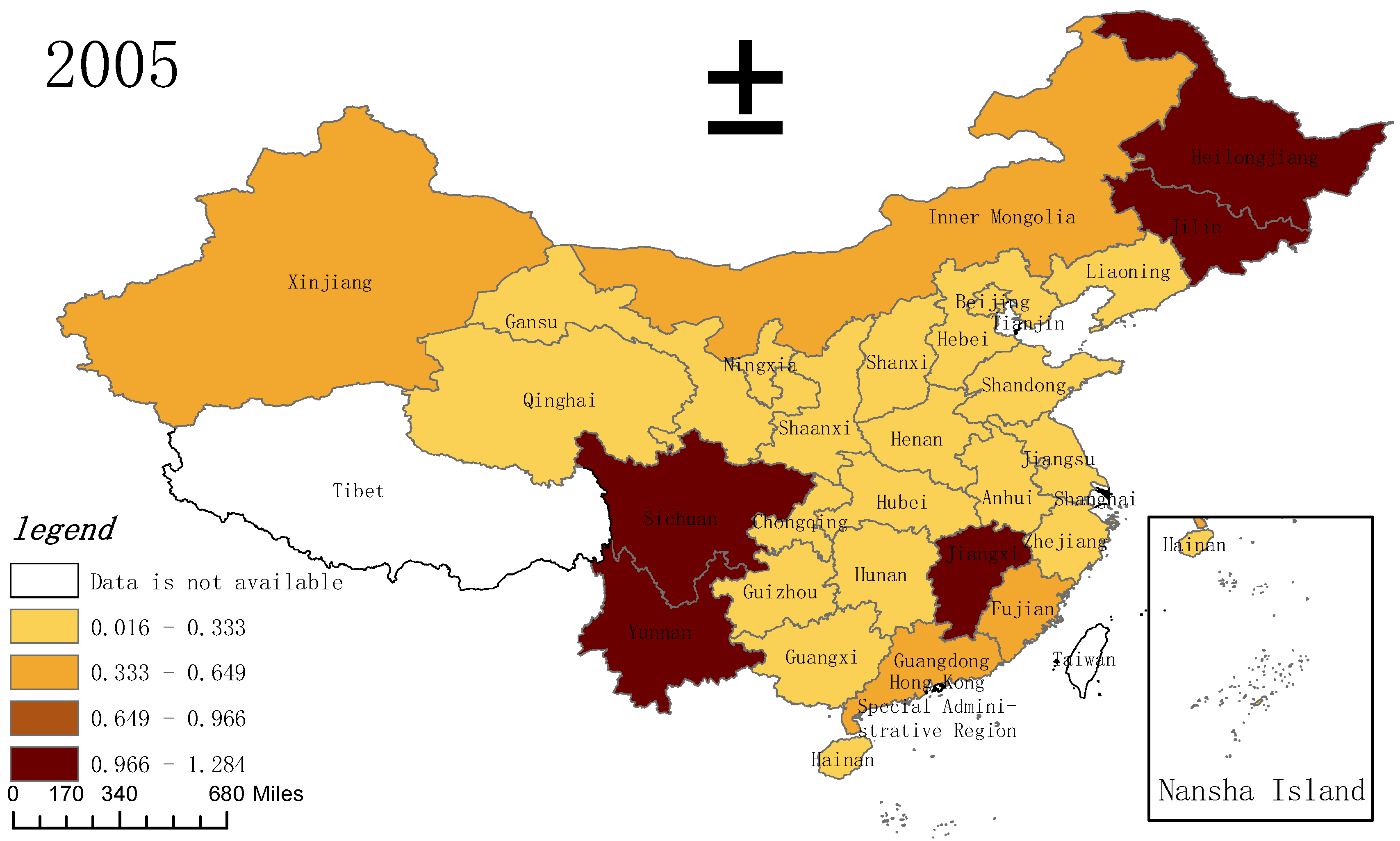
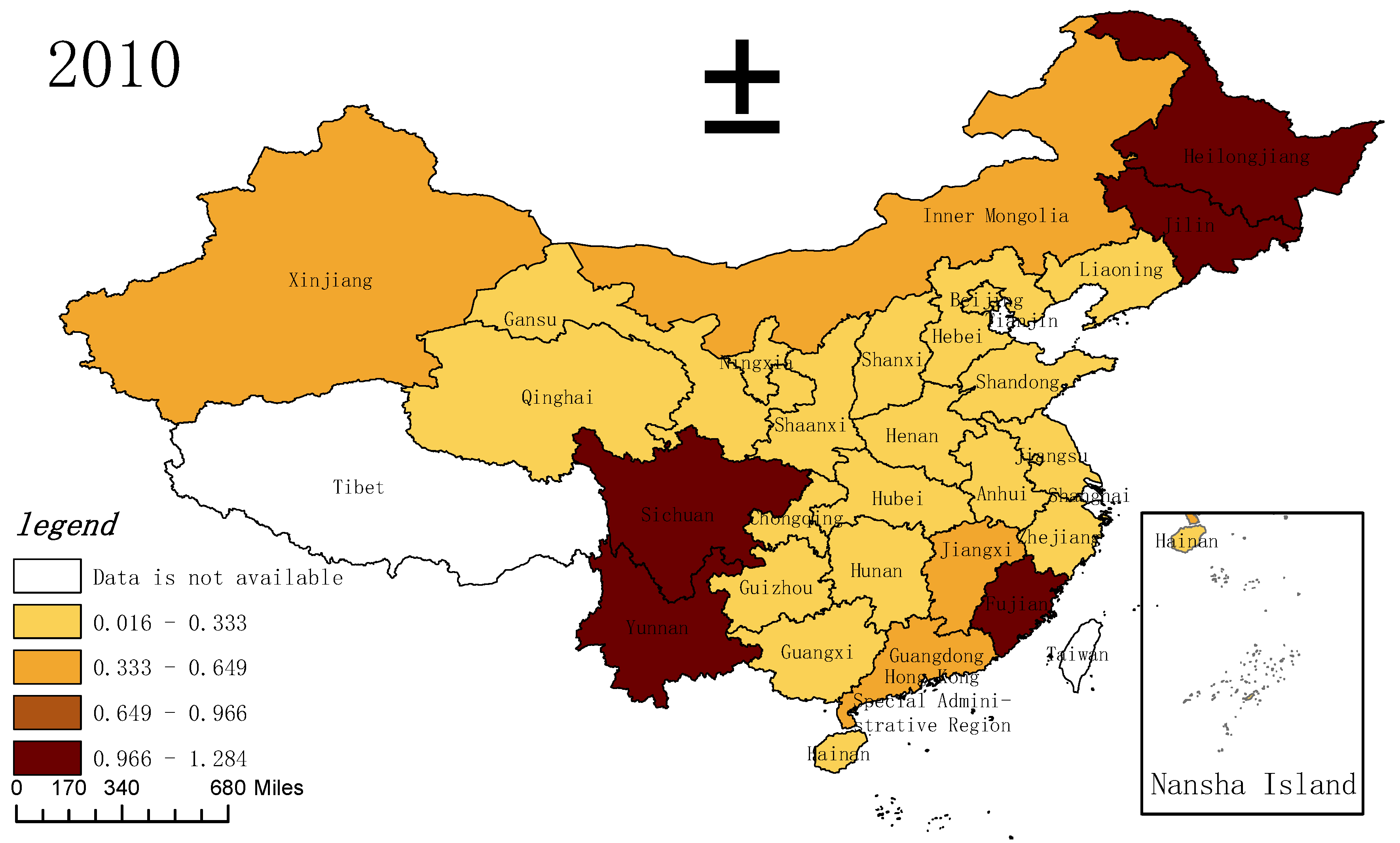
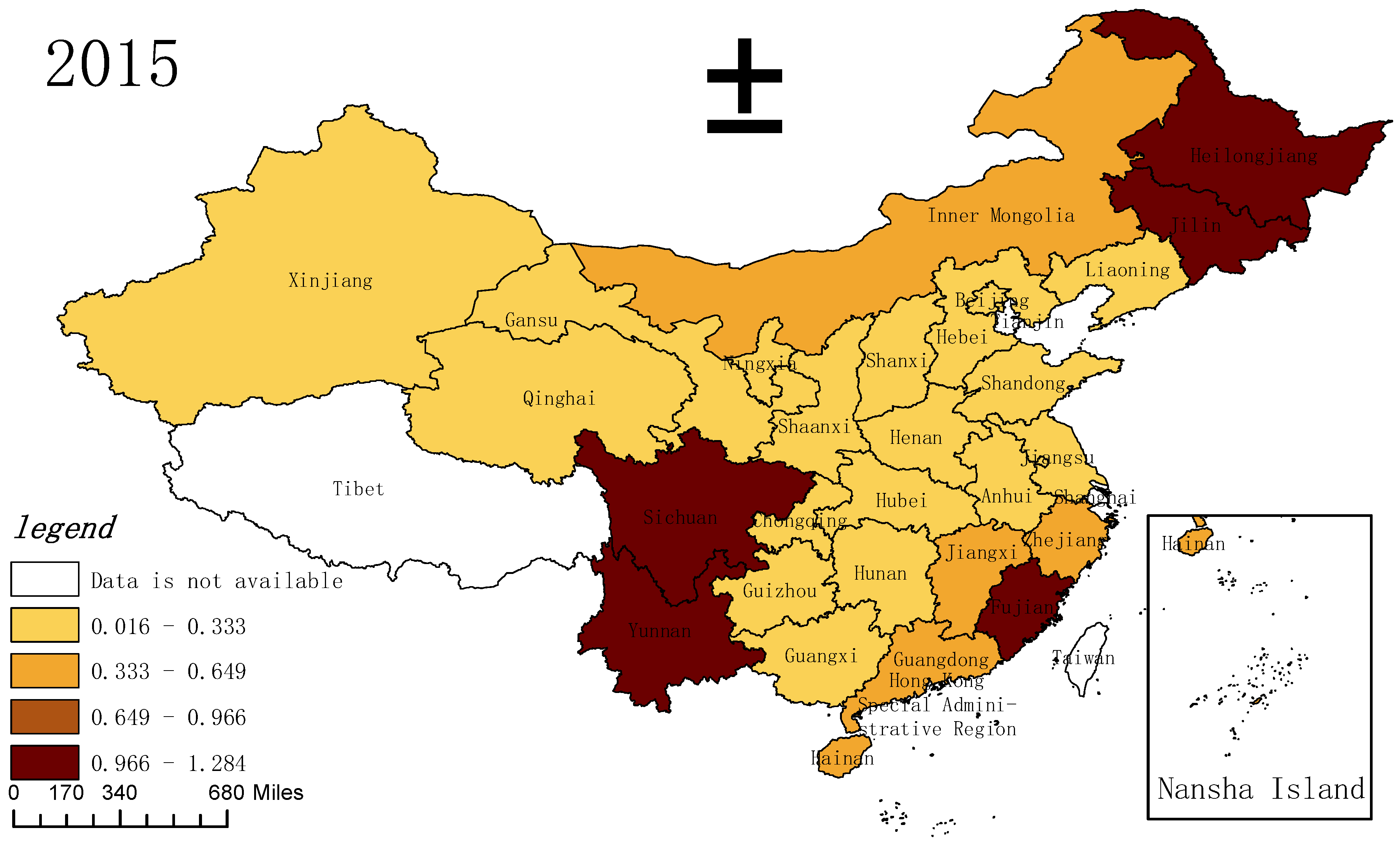
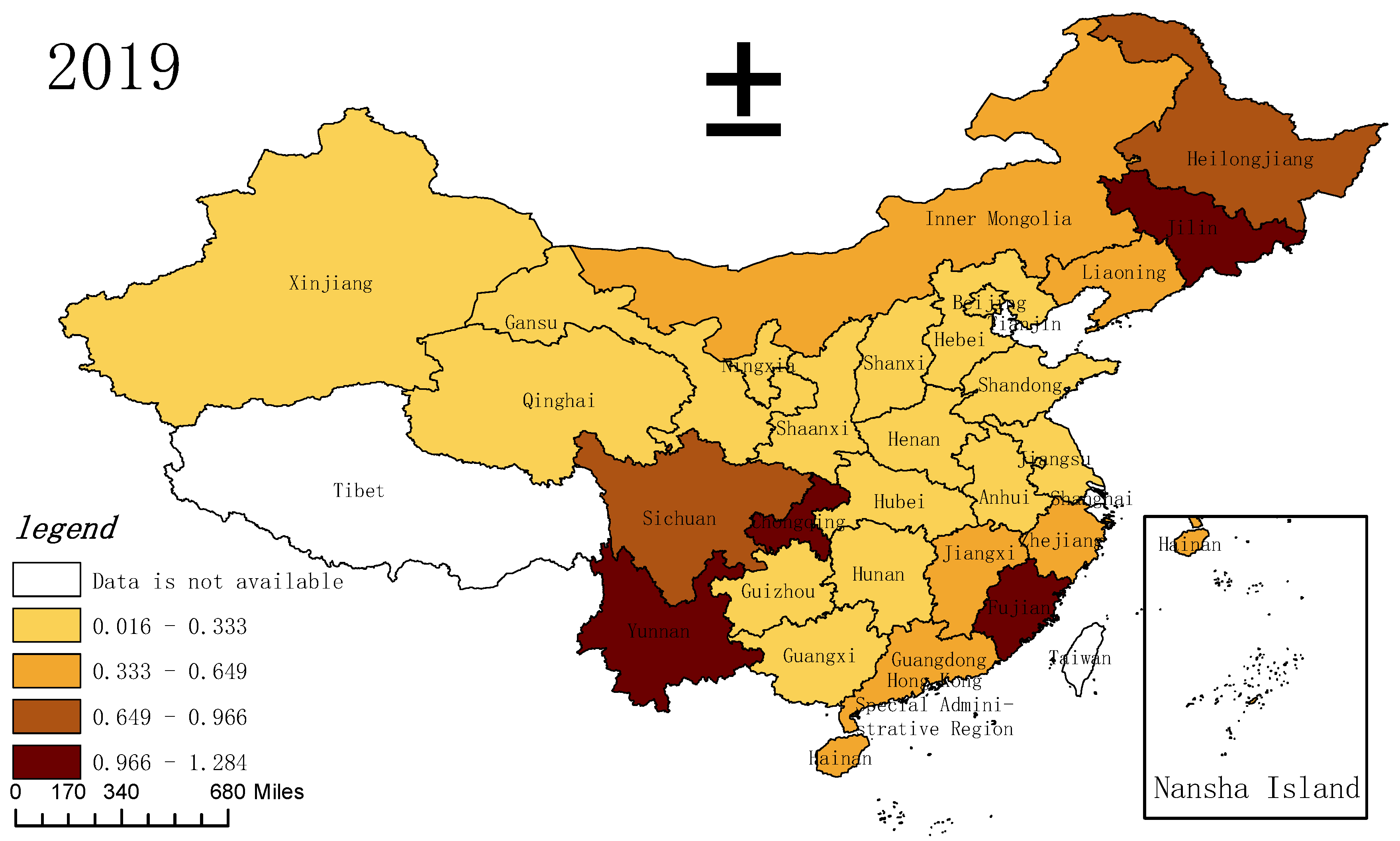
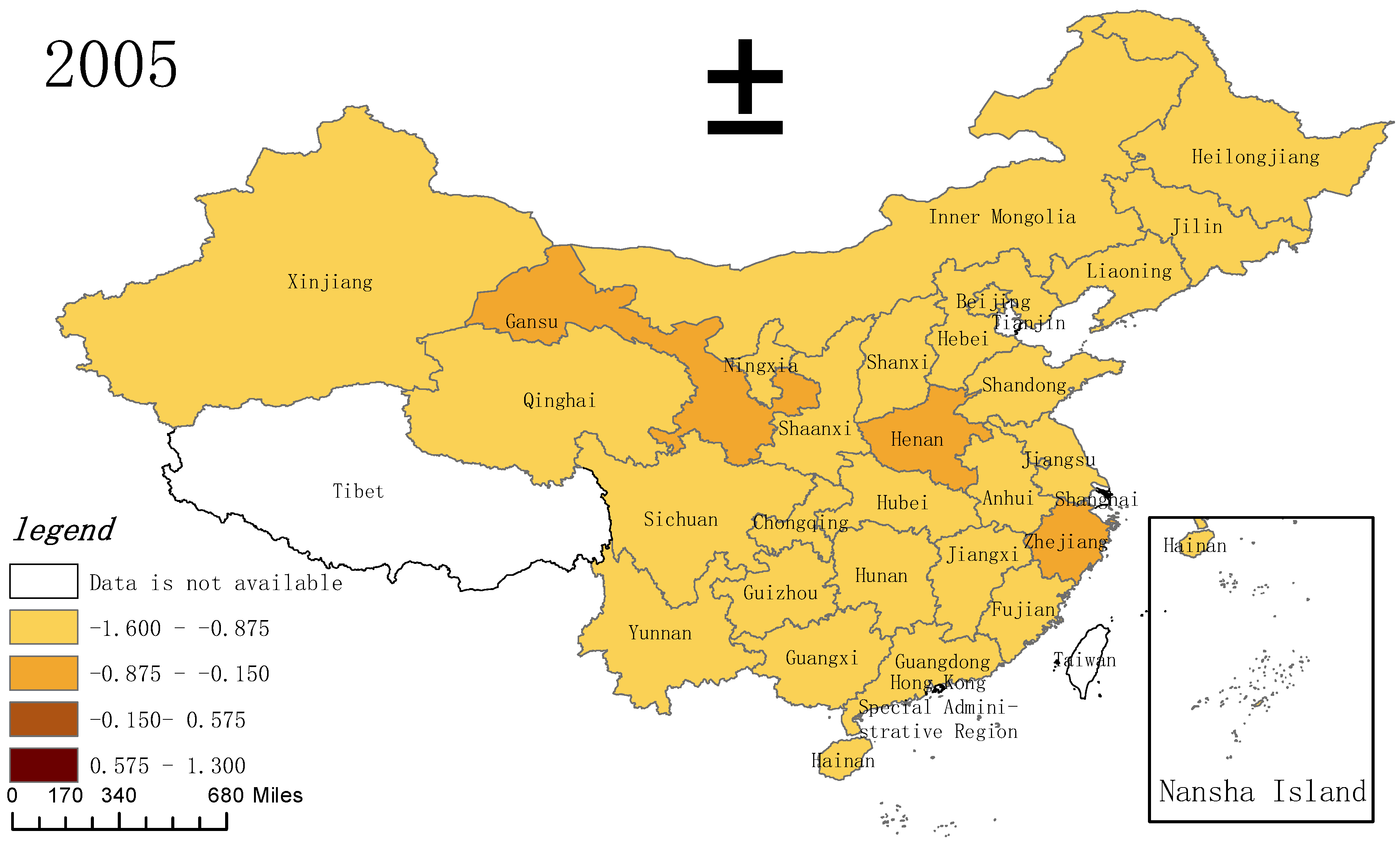
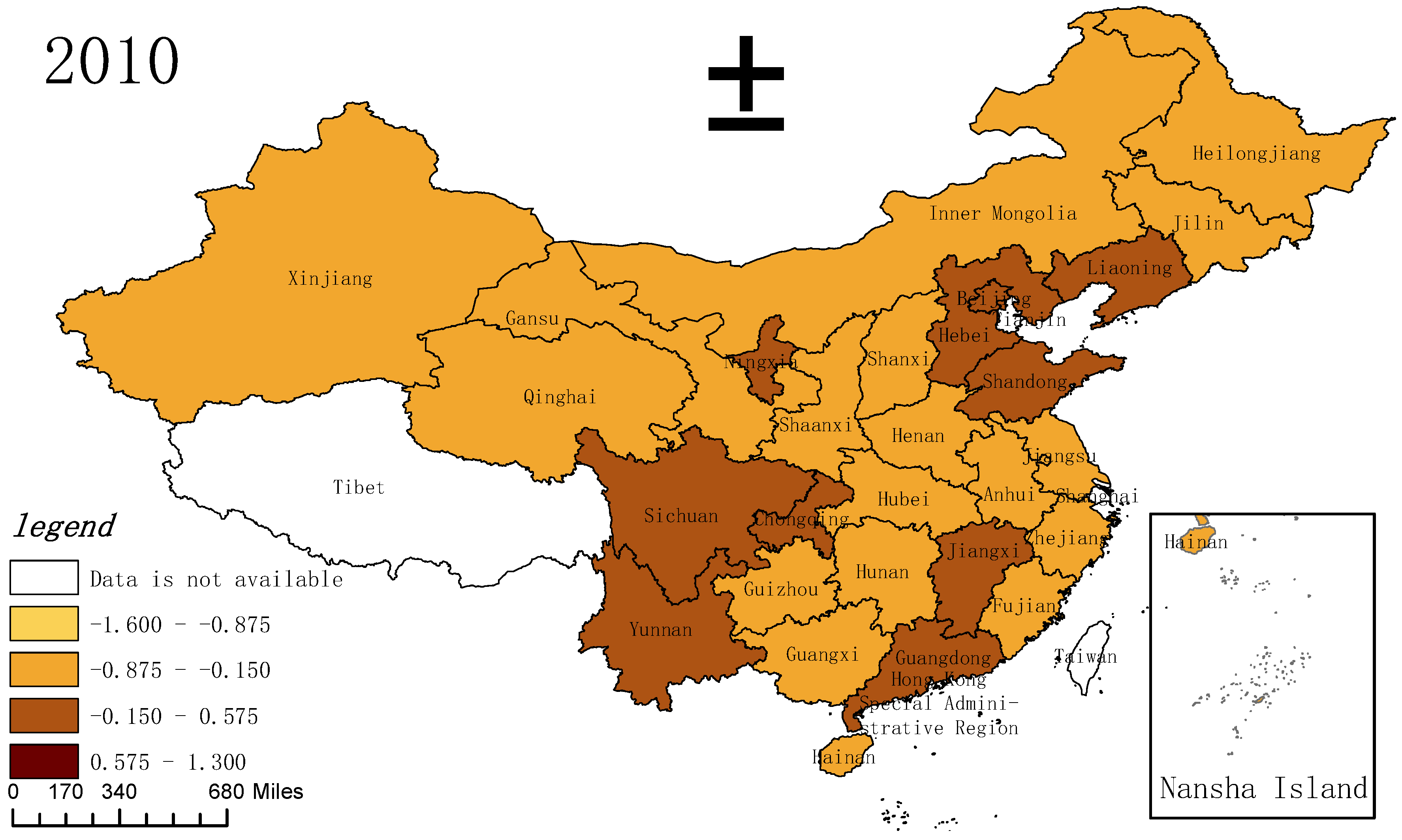

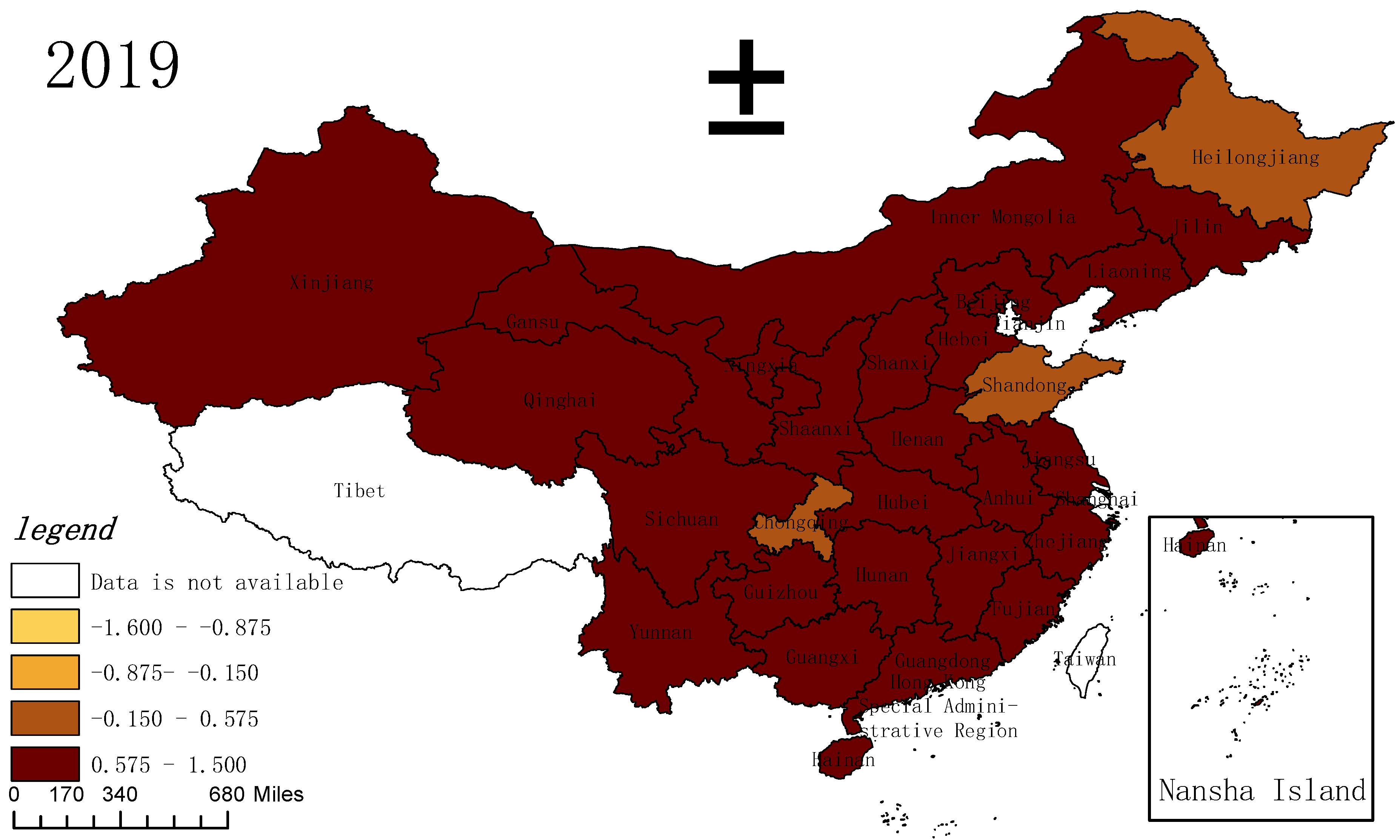
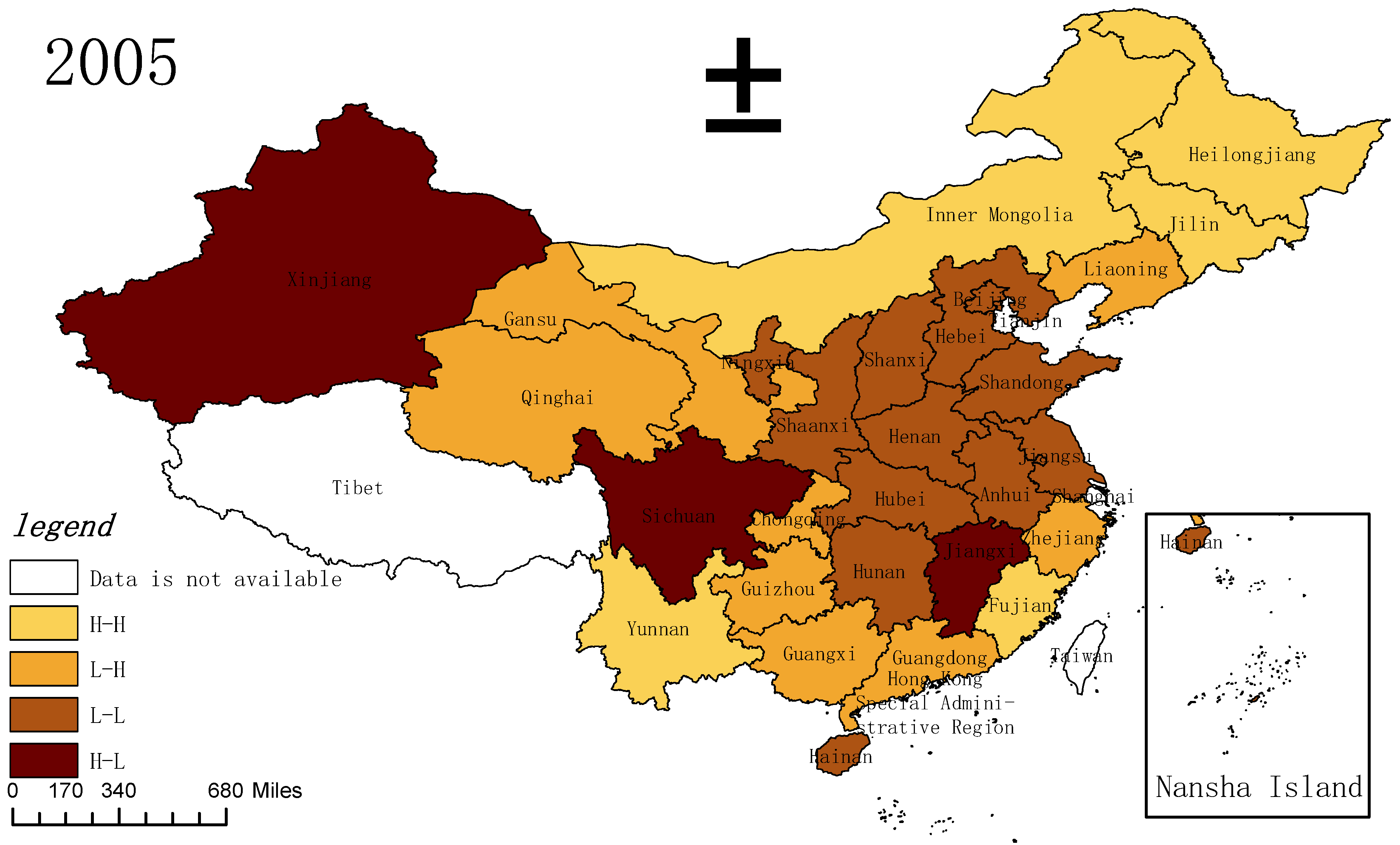
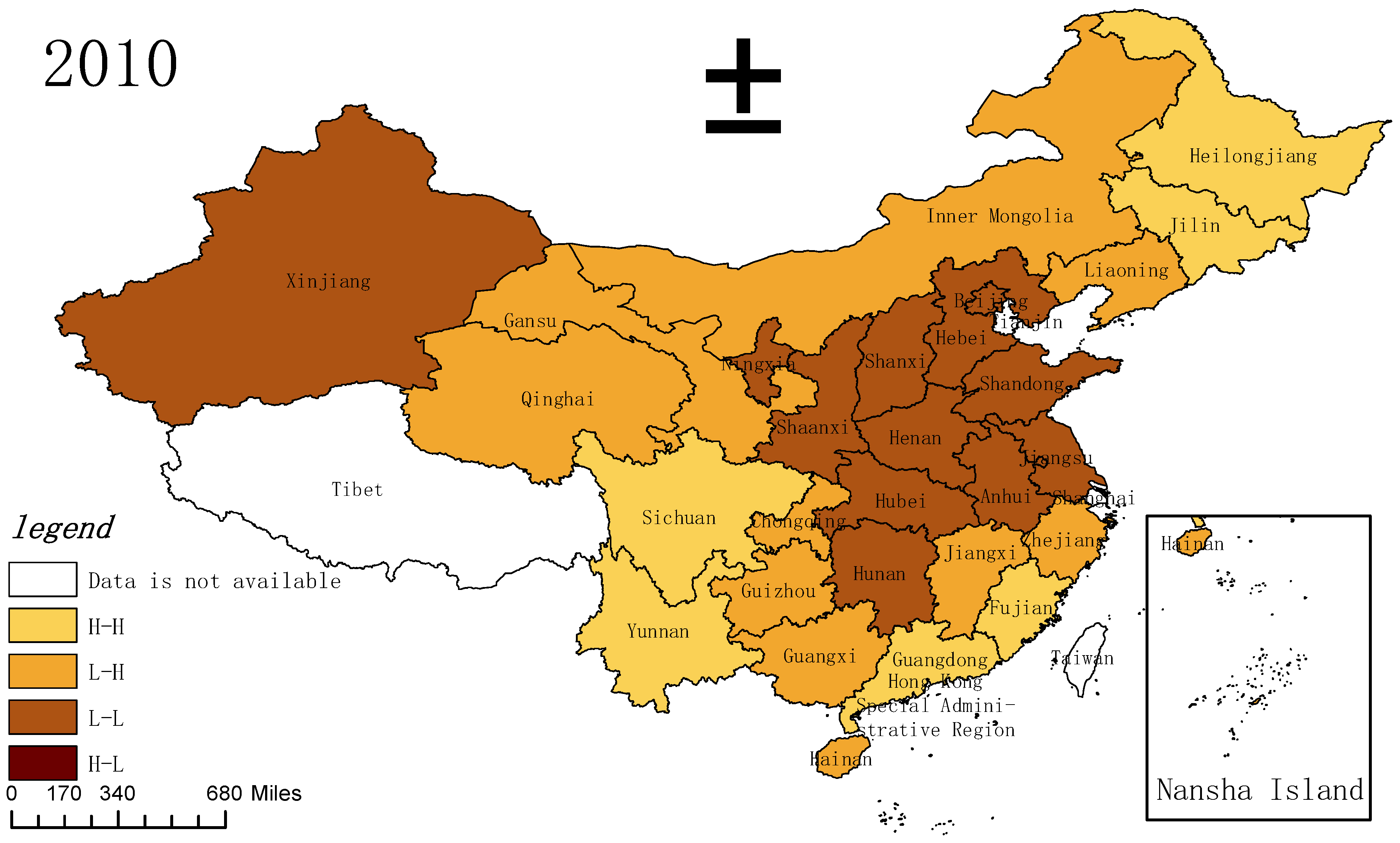
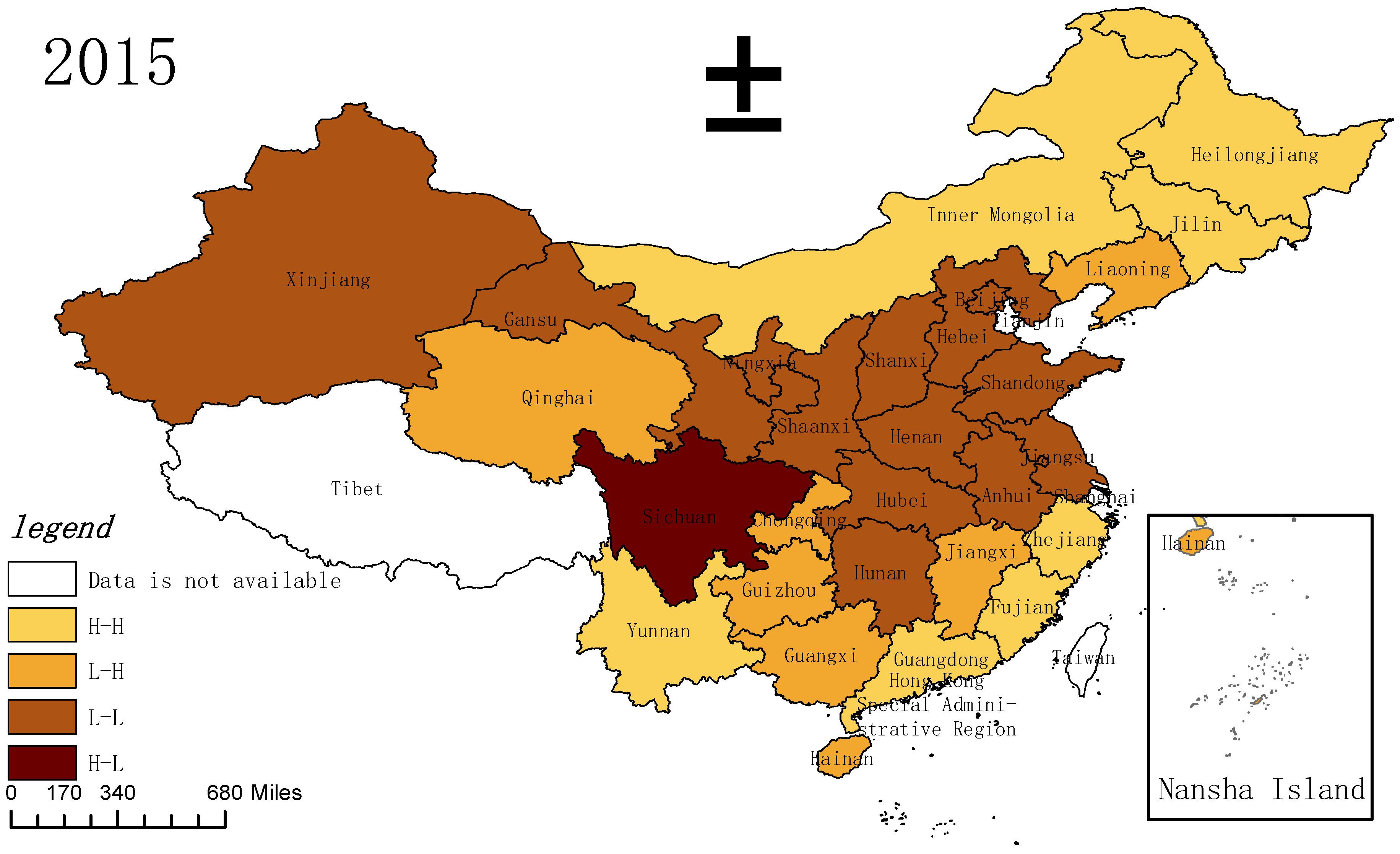

| ER | Environmental capacity indicators | Forest cover (%) |
| Afforestation area share (%) | ||
| Environmental governance indicators | The proportion of GDP invested in industrial pollution control (%) | |
| The proportion of GDP invested in environmental infrastructure (%) | ||
| The rate of harmless treatment of domestic waste (%) | ||
| The utilization rate of industrial solid waste (%) | ||
| Environmental pollutant emissions indicators | Carbon dioxide emissions per unit of output value (t/ten thousand yuan) | |
| Sewage emissions per unit of output value (t/ten thousand yuan) |
| FESE | Input | Capital stock (ten thousand yuan) |
| Land area (ten thousand ha) | ||
| Labor (ten thousand people) | ||
| Expected output | Forest volume (ten thousand m3) | |
| Non-expected outputs | Carbon dioxide emissions (ten thousand tons) |
| Name | Variables | Sample | Mean | Variance | Minimum | Maximum | VIF |
|---|---|---|---|---|---|---|---|
| Dependent variable | FESE | 420 | 0.395 | 0.376 | 0.016 | 1.289 | |
| Explanatory variables | ER | 420 | 0.000 | 0.689 | −1.550 | 1.500 | 1.68 |
| ER2 | 420 | 0.474 | 0.493 | 0.000 | 2.403 | 1.29 | |
| Other Explanatory Variables | TFESE | 420 | 0.791 | 0.804 | 0.166 | 12.061 | 1.14 |
| SFESE | 420 | 0.573 | 0.304 | 0.007 | 1.000 | 1.61 | |
| TD | 420 | 0.254 | 0.310 | 0.013 | 1.771 | 2.59 | |
| SI | 420 | 0.556 | 0.308 | 0.004 | 1.000 | 1.45 | |
| ST | 420 | 5067 | 9215 | 23 | 59,742 | 2.20 | |
| PS | 420 | 44.406 | 80.536 | 0.298 | 497.647 | 3.37 | |
| LF | 420 | 9.386 | 1.183 | 6.569 | 13.828 | 2.21 | |
| FL | 420 | 5.587 | 4.930 | 0.344 | 35.833 | 1.27 |
| Year | Adjacency Matrix | Geographical Distance Matrix | ||
|---|---|---|---|---|
| Moran’s I | p Value | Moran’s I | p Value | |
| 2005 | 0.198 | 0.030 | 0.049 | 0.012 |
| 2006 | 0.250 | 0.010 | 0.067 | 0.003 |
| 2007 | 0.215 | 0.022 | 0.056 | 0.007 |
| 2008 | 0.211 | 0.023 | 0.052 | 0.009 |
| 2009 | 0.224 | 0.018 | 0.054 | 0.008 |
| 2010 | 0.215 | 0.021 | 0.05 | 0.010 |
| 2011 | 0.225 | 0.018 | 0.053 | 0.009 |
| 2012 | 0.239 | 0.014 | 0.058 | 0.006 |
| 2013 | 0.239 | 0.014 | 0.053 | 0.009 |
| 2014 | 0.239 | 0.014 | 0.052 | 0.009 |
| 2015 | 0.234 | 0.015 | 0.052 | 0.009 |
| 2016 | 0.227 | 0.017 | 0.049 | 0.012 |
| 2017 | 0.251 | 0.011 | 0.055 | 0.008 |
| 2018 | 0.318 | 0.002 | 0.074 | 0.002 |
| 2019 | 0.189 | 0.036 | 0.049 | 0.012 |
| Test | LM Value | p Value |
|---|---|---|
| LM_test_lag | 39.991 | 0.000 |
| Robust LM_test_lag | 65.105 | 0.000 |
| LM_test_sem | 0.665 | 0.415 |
| Robust LM_test_sem | 25.779 | 0.000 |
| Variables | SAR | SEM | SDM |
|---|---|---|---|
| ER | 0.035 | 0.052 | 0.043 |
| (−0.047) | (−0.048) | (−0.044) | |
| ER2 | −0.075 ** | −0.088 ** | −0.092 *** |
| (−0.037) | (−0.038) | (−0.035) | |
| TFESE | 0.172 *** | 0.184 *** | 0.142 *** |
| (−0.014) | (−0.013) | (−0.013) | |
| SFESE | 1.066 *** | 1.099 *** | 1.037 *** |
| (−0.041) | (−0.040) | (−0.041) | |
| TD | 0.279 *** | 0.340 *** | 0.296 *** |
| (−0.052) | (−0.051) | (−0.050) | |
| SI | 0.035 | 0.108 *** | 0.031 |
| (−0.039) | (−0.041) | (−0.041) | |
| ST | 0.000 | 0.000 * | 0.000 *** |
| (0.000) | (0.000) | (0.000) | |
| PS | 0.000 | 0.000 | 0.001 *** |
| (0.000) | (0.000) | (0.000) | |
| LF | −0.058 *** | −0.061 *** | −0.126 *** |
| (−0.017) | (−0.016) | (−0.019) | |
| FL | 0.002 | −0.001 | 0.003 |
| (−0.002) | (−0.002) | (−0.002) | |
| W × ER | 0.212 ** | ||
| (−0.107) | |||
| W × ER2 | −0.158 * | ||
| (−0.088) | |||
| W × TFESE | 0.046 * | ||
| (−0.027) | |||
| W × SFESE | 0.342 *** | ||
| (−0.115) | |||
| W × TD | 0.378 *** | ||
| (−0.078) | |||
| W × SI | 0.508 *** | ||
| (−0.080) | |||
| W × ST | 0.000 *** | ||
| (0.000) | |||
| W × PS | −0.002 ** | ||
| (−0.001) | |||
| W × LF | 0.054 | ||
| (−0.038) | |||
| W × FL | −0.020 *** | ||
| (−0.006) | |||
| Rho | 0.153 ** () | −0.162 * | |
| (0.061) | (0.084) | ||
| Lambda | −0.277 *** | ||
| (0.082) | |||
| R−squared | 0.686 | 0.683 | 0.617 |
| σ−squared | 0.039 *** | 0.038 *** | 0.031 *** |
| Log−L | 83.620 | 86.001 | 132.271 |
| Variables | Direct Effects | Indirect Effects | Total Effect |
|---|---|---|---|
| ER | 0.037 | 0.181 * | 0.218 * |
| (−0.044) | (−0.094) | (−0.111) | |
| ER2 | −0.089 *** | −0.124 | −0.213 ** |
| (−0.034) | (−0.084) | (−0.095) | |
| TFESE | 0.143 *** | 0.019 | 0.162 *** |
| (−0.012) | (0.024) | (−0.023) | |
| SFESE | 1.032 *** | 0.158 * | 1.189 *** |
| (−0.041) | (−0.087) | (−0.089) | |
| TD | 0.284 *** | 0.293 *** | 0.578 *** |
| (−0.048) | (0.070) | (−0.081) | |
| SI | 0.015 | 0.451 *** | 0.466 *** |
| (−0.040) | (−0.074) | (−0.084) | |
| ST | 0.000 *** | 0.000 *** | 0.000 *** |
| (0.000) | (0.000) | (0.000) | |
| PS | 0.001 *** | −0.002 ** | −0.001 |
| (0.000) | (−0.001) | (−0.001) | |
| LF | −0.127 *** | 0.065 * | −0.063 ** |
| (−0.020) | (−0.036) | (−0.029) | |
| FL | 0.003 | −0.018 *** | −0.015 ** |
| (−0.002) | (0.006) | (−0.006) |
| Variables | Coef. | Space Coef. | Direct Effects | Indirect Effects | Total Effect |
|---|---|---|---|---|---|
| ER | 0.045 (0.049) | 0.398 (0.358) | 0.038 (0.047) | 0.257 (0.249) | 0.295 (0.270) |
| ER2 | −0.113 *** (0.040) | −0.497 * (0.290) | −0.106 *** (0.037) | −0.303 (0.213) | −0.409 * (0.227) |
| TFESE | 0.137 *** (0.014) | 0.007 (0.072) | 0.140 *** (0.013) | −0.045 (0.043) | 0.095 ** (0.046) |
| SFESE | 1.039 *** (0.040) | 2.095 *** (0.366) | 1.005 *** (0.042) | 1.081 *** (0.243) | 2.086 *** (0.241) |
| TD | 0.338 *** (0.052) | 0.537 (0.483) | 0.329 *** (0.049) | 0.258 (0.322) | 0.587 * (0.330) |
| SI | 0.047 (0.040) | 1.055 *** (0.311) | 0.025 (0.037) | 0.716 *** (0.218) | 0.741 *** (0.228) |
| ST | 0.000 * (0.000) | −0.001 (0.000) | 0.000 * (0.000) | 0.000 (0.000) | 0.000 (0.000) |
| PS | −0.000 (0.000) | −0.005 ** (0.002) | −0.000 (0.000) | −0.003 ** (0.002) | −0.003 ** (0.002) |
| LF | −0.110 *** (0.019) | 0.166 (0.136) | −0.113 *** (0.020) | 0.150 (0.097) | 0.037 (0.089) |
| FL | −0.001 (0.002) | 0.036 (0.024) | −0.001 (0.002) | 0.025 (0.018) | 0.024 (0.018) |
| Rho | −0.510 ** (0.213) | ||||
| σ−squared | 0.031 *** (0.002) | ||||
| R−squared | 0.573 | ||||
| Variables | Coef. | Space Coef. | Direct Effects | Indirect Effects | Total Effect |
|---|---|---|---|---|---|
| ER | 0.094 * (0.048) | 0.270 ** (0.113) | 0.088 * (0.049) | 0.236 ** (0.102) | 0.324 *** (0.122) |
| ER2 | −0.095 ** (0.038) | −0.226 ** (0.089) | −0.091 ** (0.037) | −0.194 ** (0.089) | −0.285 *** (0.102) |
| TFESE | 0.145 *** (0.013) | 0.050 * (0.027) | 0.146 *** (0.013) | 0.028 (0.025) | 0.174 *** (0.025) |
| SFESE | 1.048 *** (0.045) | 0.203 * (0.119) | 1.047 *** (0.045) | 0.077 (0.093) | 1.124 *** (0.098) |
| TD | 0.304 *** (0.066) | 0.430 *** (0.090) | 0.293 *** (0.064) | 0.361 *** (0.083) | 0.655 *** (0.099) |
| SI | 0.050 (0.044) | 0.722 *** (0.093) | 0.032 (0.043) | 0.661 *** (0.094) | 0.694 *** (0.112) |
| ST | −0.000 (0.000) | 0.000 *** (0.000) | -0.000 (0.000) | 0.000 *** (0.000) | 0.000 ** (0.000) |
| PS | 0.004 *** (0.001) | −0.003 * (0.002) | 0.004 *** (0.001) | −0.003 * (0.002) | 0.001 (0.001) |
| LF | −0.148 *** (0.021) | 0.062 (0.040) | −0.149 *** (0.021) | 0.071 * (0.039) | −0.077 ** (0.033) |
| FL | 0.000 (0.003) | −0.022 *** (0.007) | 0.001 (0.002) | −0.020 *** (0.007) | −0.019 ** (0.008) |
| Rho | −0.116 (0.084) | ||||
| σ−squared | 0.031*** (0.002) | ||||
| R−squared | 0.535 | ||||
Disclaimer/Publisher’s Note: The statements, opinions and data contained in all publications are solely those of the individual author(s) and contributor(s) and not of MDPI and/or the editor(s). MDPI and/or the editor(s) disclaim responsibility for any injury to people or property resulting from any ideas, methods, instructions or products referred to in the content. |
© 2023 by the authors. Licensee MDPI, Basel, Switzerland. This article is an open access article distributed under the terms and conditions of the Creative Commons Attribution (CC BY) license (https://creativecommons.org/licenses/by/4.0/).
Share and Cite
Lu, H.; Zhang, M.; Nian, W. The Spatial Spillover Effects of Environmental Regulations on Forestry Ecological Security Efficiency in China. Sustainability 2023, 15, 1875. https://doi.org/10.3390/su15031875
Lu H, Zhang M, Nian W. The Spatial Spillover Effects of Environmental Regulations on Forestry Ecological Security Efficiency in China. Sustainability. 2023; 15(3):1875. https://doi.org/10.3390/su15031875
Chicago/Turabian StyleLu, Hongliang, Min Zhang, and Wei Nian. 2023. "The Spatial Spillover Effects of Environmental Regulations on Forestry Ecological Security Efficiency in China" Sustainability 15, no. 3: 1875. https://doi.org/10.3390/su15031875




